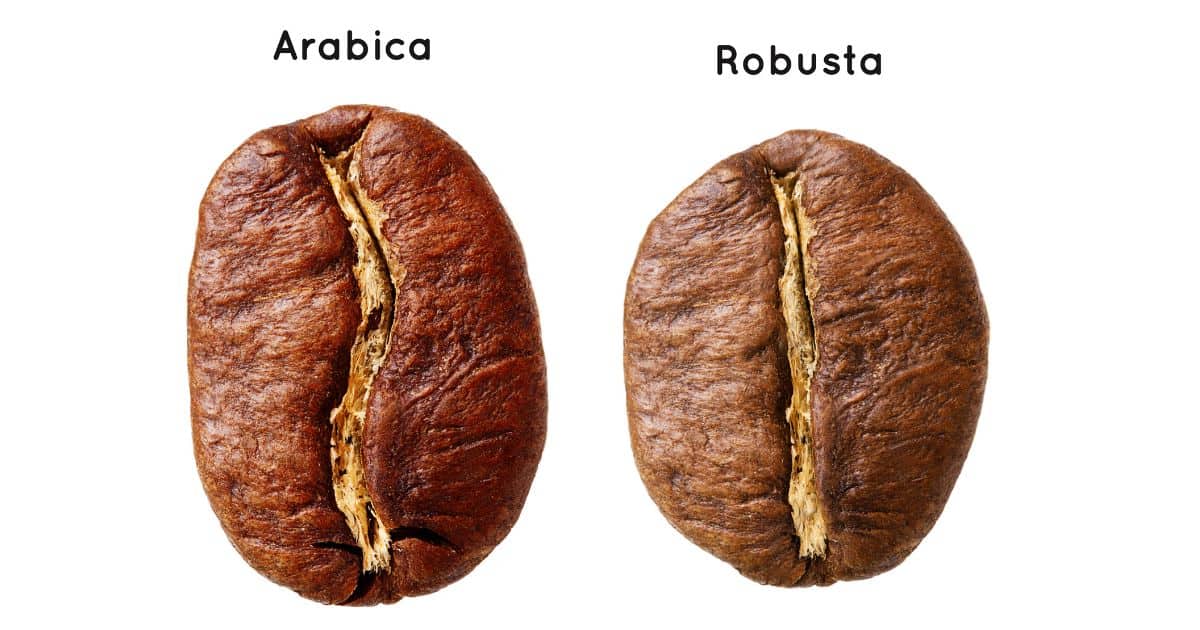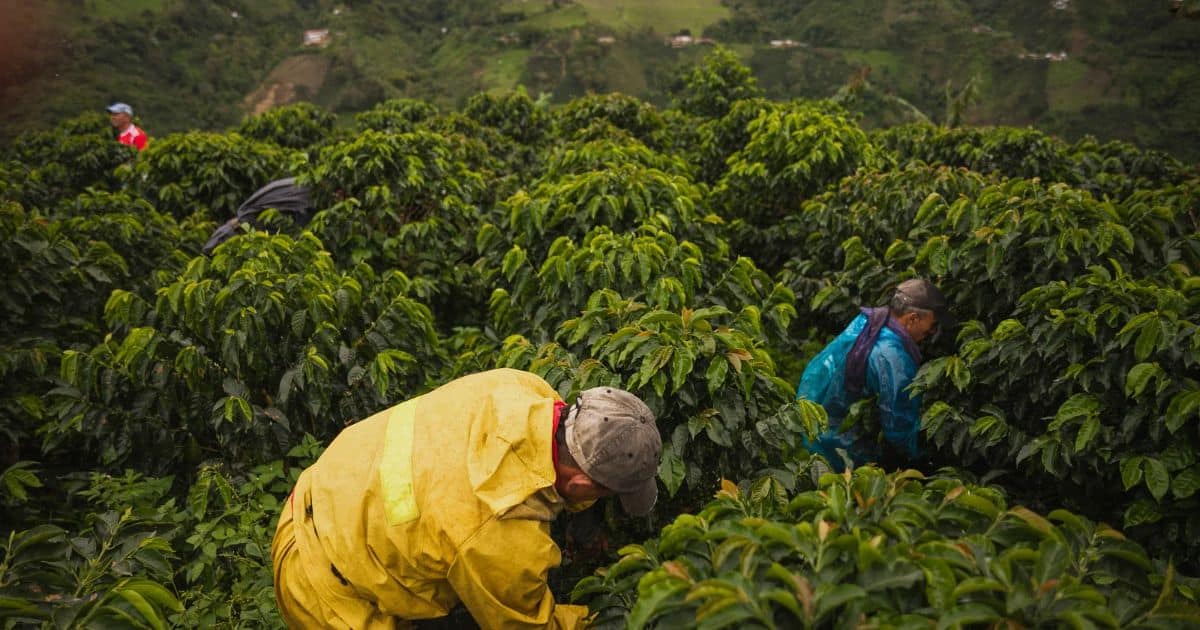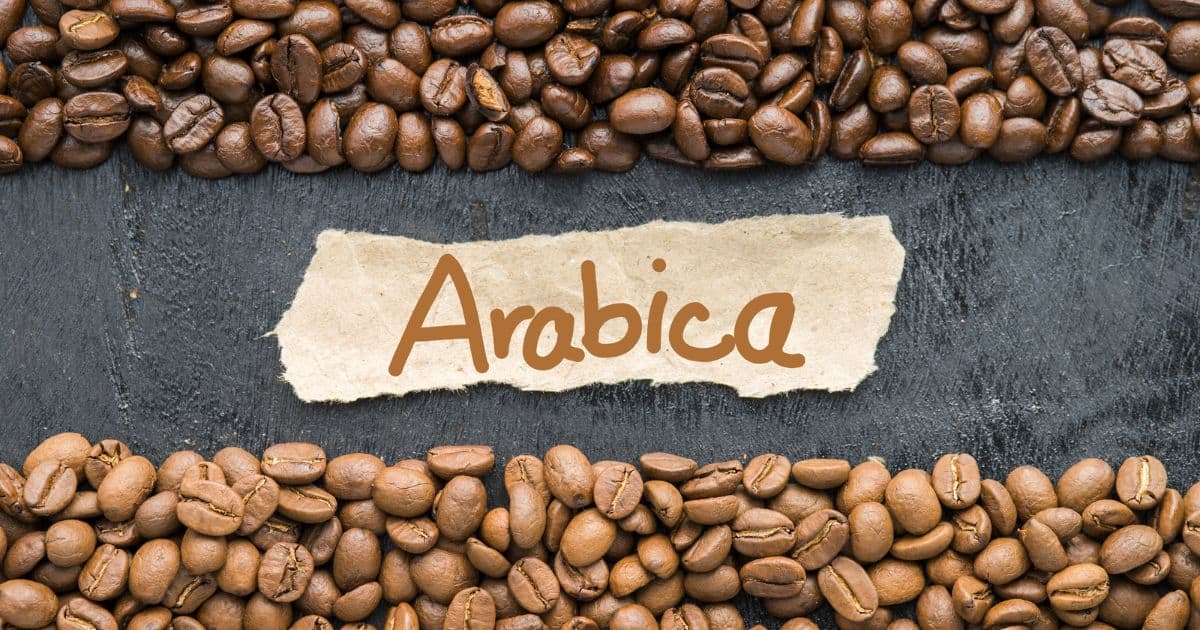Imagine you’re standing in the coffee aisle, trying to pick out the perfect blend for your morning cup of joe. You notice there are bags labeled “Arabica” and others labeled “Robusta.” You’re puzzled, as you’ve never really thought about the different types of coffee beans before.

Don’t worry, you’re not the only one who’s been caught off guard by the great Arabica vs. Robusta coffee debate!
In this beginner-friendly article, we’ll be guiding you through the basics, answering questions like:
What’s the difference between Arabica coffee beans and Robusta coffee beans?
Which one is better for my morning coffee?
Are there other types of coffee beans I should know about?
Is Robusta really the strongest coffee?
What’s so special about Robusta coffee?
Join us on this caffeinated journey as we explore the diverse world of coffee beans and help you make an informed decision for your next brew!
Arabica And Robusta: A Brief Overview
Before we dive into the nitty-gritty of the Arabica vs. Robusta showdown, let’s quickly get acquainted with these two coffee bean heavyweights.
Arabica Coffee:
The most popular coffee bean globally, accounting for around 60-70% of the world’s coffee production.
Known for its smooth, mild flavor, and slightly sweet taste with hints of fruit and chocolate.
Grown at higher elevations (usually 2,000-6,000 feet above sea level) in countries like Brazil, Colombia, and Ethiopia.
Robusta Coffee:
The second most popular coffee bean, making up around 30-40% of the world’s coffee production.
Often described as having a stronger, more bitter taste than Arabica, with a nutty, earthy flavor.
Grown at lower elevations (usually 0-2,000 feet above sea level) in countries like Vietnam, Uganda, and Indonesia.
Now that you’ve got a basic understanding of what Arabica and Robusta are, let’s explore their differences and see which bean reigns supreme in the battle for coffee supremacy!

Differences Between Arabica And Robusta
To help you understand the Arabica vs. Robusta debate, let’s delve into their key differences, including taste, caffeine content, and growing conditions.
Taste And Flavor Profile:
Arabica beans offer a more delicate, mild flavor, often with fruity, floral, or chocolatey notes. They tend to have a balanced acidity and a smooth, well-rounded finish.
Robusta coffee beans, on the other hand, pack a bolder, more bitter punch. They typically have an earthy, nutty taste and a heavier body, sometimes with a hint of a woody or rubbery aftertaste.
Caffeine Content:
Arabica beans contain less caffeine, usually around 1-1.5% by weight.
Robusta beans boast almost double the caffeine, clocking in at around 2-2.7% by weight. That extra kick of caffeine contributes to their stronger, more bitter flavor.
Growing Conditions And Cultivation:

Arabica plants thrive in higher altitudes and cooler temperatures, requiring more care and attention from farmers. They’re also more susceptible to pests and diseases, making them a bit trickier to cultivate.
Robusta plants are hardier, growing well in lower elevations and warmer temperatures. They’re more resistant to pests and diseases, which can make them a more economical choice for farmers.
The 4 Types Of Coffee Beans
While Arabica coffee beans and the Robusta coffee bean are the two coffee beans that are most common. There are actually two other lesser-known varieties you might encounter in your coffee adventures. Let’s take a brief look at all four types:
Arabica Bean: As mentioned earlier, these beans are famous for their smooth, mild taste and are the most widely consumed coffee beans in the world.
Robusta Bean: Known for their stronger, more bitter flavor profile, these beans pack a punch with their higher caffeine content.
Liberica Bean: A rarer variety, Liberica beans are primarily grown in the Philippines. They’re known for their unique, fruity flavor and aroma, often described as having a “floral” or “woody” character.
Excelsa Bean: Technically a sub-variety of Liberica, Excelsa beans are grown mainly in Southeast Asia. They’re celebrated for their tart, fruity taste and complex flavor profile, which can add depth to coffee blends.
Now that you’re familiar with the four types of coffee beans, let’s dive back into the Arabica vs. Robusta debate and figure out which one might be the best choice for you.
Related Article: French Roast Coffee: The Ultimate Guide for Dark Roast Lovers
Which Is Better: Arabica Or Robusta?
Now that you understand the differences between Arabica and Robusta, you might be wondering which one is better for your morning brew. The answer, as with many things in life, depends on your personal preferences and how you like your coffee. Here are some factors to consider:

Taste: If you’re after a smooth, mild, and well-balanced cup of coffee, Arabica is your go-to bean. However, if you prefer a bolder, more intense flavor, you might want to give Robusta a try.
Strength: Robusta beans have a higher caffeine content, which can translate to a more robust, energizing cup of coffee. If you need that extra kick to get you going in the morning, Robusta might be the way to go.
Price: Arabica beans are often more expensive due to their higher cultivation costs and overall popularity. If you’re on a budget, Robusta beans can be a more affordable option without sacrificing too much on taste.
Ultimately, the choice between Arabica and Robusta comes down to personal taste and priorities. You might even consider experimenting with blends that combine the best of both worlds!
Related Article: Is Kopi Luwak Worth the Hype? The Truth Behind Civet Cat Coffee
Is Robusta The Strongest Coffee?
In terms of caffeine content, Robusta is indeed stronger than Arabica, as it boasts nearly double the caffeine levels. This extra jolt of caffeine can make Robusta a popular choice for those who need a more potent pick-me-up or prefer a drink with a bolder, more intense flavor.

However, it’s important to note that strength can be subjective and might also depend on factors such as roast level, brewing method, and personal taste preferences. For example, a dark-roasted Arabica coffee can taste quite strong and bold, even though it has less caffeine than Robusta.
So while Robusta is generally considered the stronger coffee in terms of caffeine content, you may find that other factors influence your perception of strength in your morning cup.
Related Article: Italian Roast Coffee: Flavor, Caffeine, And Everything You Need To Know!
The Future Of Robusta
So, what’s next for Robusta coffee? Despite its historically less favorable reputation compared to Arabica, Robusta has a lot going for it. Let’s take a look at what makes Robusta coffee special and how it’s evolving in the world of coffee.
- Climate resilience: As a hardier coffee plant, that can withstand warmer temperatures, Robusta may become increasingly important in the face of climate change. As conditions become more challenging for Arabica cultivation, Robusta could help meet the growing global demand for coffee.
- Improving quality: With advances in cultivation practices and a growing interest in specialty coffee, Robusta’s quality is steadily improving. Farmers and coffee producers are experimenting with new processing techniques and investing in better bean selection, leading to tastier Robusta coffees that can rival some Arabica beans in terms of flavor.
- Blending potential: Robusta’s unique characteristics, such as its bold flavor and high caffeine content, make it an excellent candidate for blending with other coffee varieties. Many espresso blends, for example, use a mix of Arabica and Robusta beans to achieve the perfect balance of flavor, strength, and crema.
Robusta coffee has a bright future ahead as its quality continues to improve, and its role in the coffee industry becomes more prominent. Keep an eye out for innovative Robusta blends and offerings that could change your perception of this underrated coffee bean.
Key Takeaways
Before we wrap up, let’s quickly recap the most important insights from our Arabica vs. Robusta exploration:
Arabica beans have a milder, smoother flavor, while Robusta coffee beans boast a bolder, more intense taste.
Robusta has nearly double the caffeine content of Arabica, making it a stronger choice for caffeine lovers.
Arabica and Robusta coffee beans have different growing conditions, with Arabica preferring higher elevations and cooler temperatures, while Robusta thrives at lower elevations and in warmer climates.
In addition to Arabica and Robusta, there are two lesser-known coffee bean varieties: Liberica and Excelsa.
The future of Robusta looks promising, as improvements in cultivation practices, blending potential, and climate resilience drive its growth in the coffee industry.
The Final Sip: Arabica Vs. Robusta Showdown
And there you have it – a comprehensive look at the fascinating world of Arabica and Robusta coffee beans. As you’ve seen, each type of bean has its unique characteristics, strengths, and flavor profiles, which cater to different personal tastes and preferences.
Ultimately, the choice between Arabica and Robusta comes down to what you enjoy most in a cup of coffee. Don’t be afraid to experiment with both varieties and even explore blends that combine the best of both worlds.
By broadening your coffee horizons, you’ll not only gain a deeper appreciation for your daily brew but also discover new and exciting flavors along the way.
So next time you find yourself in the coffee aisle or at your favorite café, why not give Robusta a chance, or perhaps indulge in a luxurious Arabica blend? Either way, happy caffeinating!
Frequently Asked Questions
Is Starbucks Coffee Robusta Or Arabica?
Starbucks primarily uses Arabica coffee beans for its beverages. The company is committed to sourcing high-quality Arabica beans, which are known for their smoother, milder flavor profile compared to Robusta beans.
Which Coffee Beans Are Robusta?
Robusta coffee beans are primarily grown in countries like Vietnam, Uganda, and Indonesia. Some popular Robusta varieties include the Indian Cherry Robusta and the Indonesian Sumatra Mandheling. When shopping for coffee, you can typically find Robusta beans labeled as such on the packaging or in the product description.
What Is The Best Brewing Method For Robusta Coffee?
While there is no one-size-fits-all answer to this question, the Robusta bean is often used in espresso blends due to their bold flavor and high caffeine content. The espresso brewing method extracts a concentrated, strong coffee that can highlight Robusta’s unique characteristics.
However, feel free to experiment with other brewing methods like drip, pour-over, or French press to find the one that suits your taste preferences best.
Can I Mix Arabica And Robusta Beans At Home?
Absolutely! Mixing Arabica and Robusta beans can create a balanced and complex flavor profile in your coffee. Try experimenting with different ratios of Arabica and Robusta beans to find the blend that best suits your taste preferences.
Start with a higher percentage of Arabica beans for a milder, smoother coffee and gradually increase the Robusta content if you’re looking for a bolder, more intense flavor.
How Do I Store My Coffee Beans To Keep Them Fresh?
To maintain the freshness of your coffee beans, store them in an airtight container away from direct sunlight, heat, and moisture. It’s best to keep your coffee beans at room temperature in a cool, dark place like a pantry or cabinet.
Additionally, avoid storing your beans in the refrigerator or freezer, as the fluctuating temperatures and humidity of cold temperatures can negatively affect their flavor and freshness.
